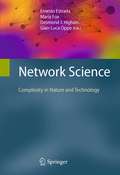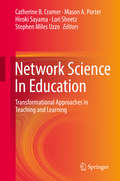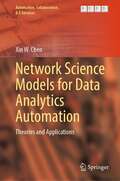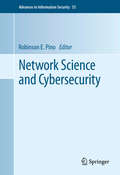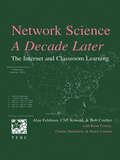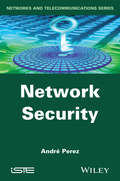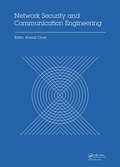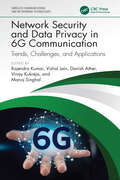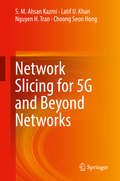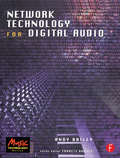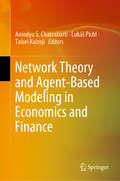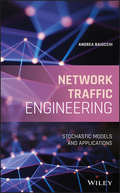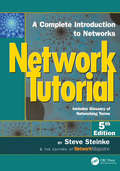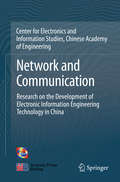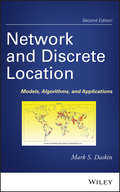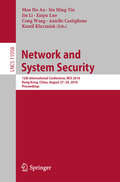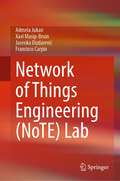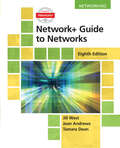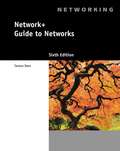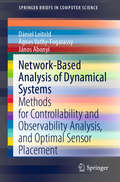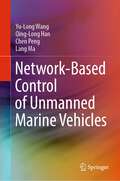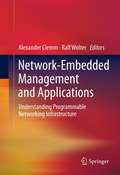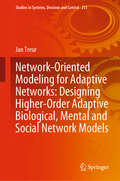- Table View
- List View
Network Science
by Desmond J. Higham Gian-Luca Oppo Ernesto Estrada Maria FoxNetwork Science is the emerging field concerned with the study of large, realistic networks. This interdisciplinary endeavor, focusing on the patterns of interactions that arise between individual components of natural and engineered systems, has been applied to data sets from activities as diverse as high-throughput biological experiments, online trading information, smart-meter utility supplies, and pervasive telecommunications and surveillance technologies. This unique text/reference provides a fascinating insight into the state of the art in network science, highlighting the commonality across very different areas of application and the ways in which each area can be advanced by injecting ideas and techniques from another. The book includes contributions from an international selection of experts, providing viewpoints from a broad range of disciplines. It emphasizes networks that arise in nature--such as food webs, protein interactions, gene expression, and neural connections--and in technology--such as finance, airline transport, urban development and global trade. Topics and Features: begins with a clear overview chapter to introduce this interdisciplinary field; discusses the classic network science of fixed connectivity structures, including empirical studies, mathematical models and computational algorithms; examines time-dependent processes that take place over networks, covering topics such as synchronisation, and message passing algorithms; investigates time-evolving networks, such as the World Wide Web and shifts in topological properties (connectivity, spectrum, percolation); explores applications of complex networks in the physical and engineering sciences, looking ahead to new developments in the field. Researchers and professionals from disciplines as varied as computer science, mathematics, engineering, physics, chemistry, biology, ecology, neuroscience, epidemiology, and the social sciences will all benefit from this topical and broad overview of current activities and grand challenges in the unfolding field of network science.
Network Science In Education: Transformational Approaches in Teaching and Learning
by Mason A. Porter Hiroki Sayama Catherine B. Cramer Lori Sheetz Stephen Miles UzzoAround the globe, there is an increasingly urgent need to provide opportunities for learners to embrace complexity; to develop the many skills and habits of mind that are relevant to today's complex and interconnected world; and to make learning more connected to our rapidly changing workplace and society. This presents an opportunity to (1) leverage new paradigms for understanding the structure and function of teaching and learning communities, and (2) to promote new approaches to developing methods, curricular materials, and resources. Network science - the study of connectivity - can play an important role in these activities, both as an important subject in teaching and learning and as a way to develop interconnected curricula. Since 2010, an international community of network science researchers and educators has come together to raise the global level of network literacy by applying ideas from network science to teaching and learning. Network Science in Education - which refers to both this community and to its activities - has evolved in response to the escalating activity in the field of network science and the need for people to be able to access the field through education channels. Network Science In Education: Transformational Approaches in Teaching and Learning appeals to both instructors and professionals, while offering case studies from a wide variety of activities that have been developed around the globe: the creation of entirely new courses and degree programs; tools for K-20 learners, teachers, and the general public; and in-depth analysis of selected programs. As network-based pedagogy and the community of practice continues to grow, we hope that the book's readers will join this vibrant network education community to build on these nascent ideas and help deepen the understanding of networks for all learners.
Network Science Models for Data Analytics Automation: Theories and Applications (Automation, Collaboration, & E-Services #9)
by Xin W. ChenThis book explains network science and its applications in data analytics for critical infrastructures, engineered systems, and knowledge acquisition. Each chapter describes step-by-step processes of how network science enables and automates data analytics through examples. The book not only dissects modeling techniques and analytical results but also explores the intrinsic development of these models and analyses. This unique approach bridges the gap between theory and practice and channels’ managerial and problem-solving skills. Engineers, researchers, and managers would benefit from the extensive theoretical background and practical examples discussed in this book. Advanced undergraduate students and graduate students in mathematics, statistics, engineering, business, public health, and social science may use this book as a one-semester textbook or a reference book. Readers who are more interested in applications may skip Chapter 1 and peruse through the rest of the book with ease.
Network Science and Cybersecurity
by Robinson E. PinoNetwork Science and Cybersecurity introduces new research and development efforts for cybersecurity solutions and applications taking place within various U.S. Government Departments of Defense, industry and academic laboratories. This book examines new algorithms and tools, technology platforms and reconfigurable technologies for cybersecurity systems. Anomaly-based intrusion detection systems (IDS) are explored as a key component of any general network intrusion detection service, complementing signature-based IDS components by attempting to identify novel attacks. These attacks may not yet be known or have well-developed signatures. Methods are also suggested to simplify the construction of metrics in such a manner that they retain their ability to effectively cluster data, while simultaneously easing human interpretation of outliers. This is a professional book for practitioners or government employees working in cybersecurity, and can also be used as a reference. Advanced-level students in computer science or electrical engineering studying security will also find this book useful .
Network Science, A Decade Later: The Internet and Classroom Learning
by Alan Feldman Cliff Konold Bob Coulter Brian ConroyNetwork Science, A Decade Later--the result of NSF-funded research that looked at the experiences of a set of science projects which use the Internet--offers an understanding of how the Internet can be used effectively by science teachers and students to support inquiry-based teaching and learning. The book emphasizes theoretical and critical perspectives and is intended to raise questions about the goals of education and the ways that technology helps reach those goals and ways that it cannot. The theoretical perspective of inquiry-based teaching and learning in which the book is grounded is consistent with the current discipline-based curriculum standards and frameworks. The chapters in Part I, "State of the Art," describe the history and current practice of network science. Those in Part II, "Looking Deeply," extend the inquiry into network science by examining discourse and data in depth, using both empirical data and theoretical perspectives. In Part III, "Looking Forward," the authors step back from the issues of network science to take a broader view, focusing on the question: How should the Internet be used--and not used--to support student learning? The book concludes with a reminder that technology will not replace teachers. Rather, the power of new technologies to give students both an overwhelming access to resources--experts, peers, teachers, texts, images, and data--and the opportunity to pursue questions of their own design, increases the need for highly skilled teachers and forward-looking administrators. This is a book for them, and for all educators, policymakers, students involved in science and technology education. For more information about the authors, an archived discussions space, a few chapters that can be downloaded as PDF files, and ordering information, visit teaparty.terc.edu/book/
Network Security
by André PerezThis book introduces the security mechanisms deployed in Ethernet, Wireless-Fidelity (Wi-Fi), Internet Protocol (IP) and MultiProtocol Label Switching (MPLS) networks. These mechanisms are grouped throughout the book according to the following four functions: data protection, access control, network isolation, and data monitoring.Data protection is supplied by data confidentiality and integrity control services. Access control is provided by a third-party authentication service. Network isolation is supplied by the Virtual Private Network (VPN) service. Data monitoring consists of applying rules to data in order to authorize its transfer or detect attacks.The chapters of the book cover cryptography, 802.1x mechanism, WPA mechanisms, IPSec mechanism, SSL/TLS/DTLS protocols, network management, MPLS technology, Ethernet VPN, firewalls and intrusion detection.
Network Security and Communication Engineering: Proceedings of the 2014 International Conference on Network Security and Communication Engineering (NSCE 2014), Hong Kong, December 25-26, 2014
by Kennis ChanThe conference on network security and communication engineering is meant to serve as a forum for exchanging new developments and research progresss between scholars, scientists and engineers all over the world and providing a unique opportunity to exchange information, to present the latest results as well as to review the relevant issues on
Network Security and Data Privacy in 6G Communication: Trends, Challenges, and Applications (Wireless Communications and Networking Technologies)
by Rajendra Kumar Vishal Jain Vinay Kukreja Danish AtherThis book proposes robust solutions for securing a network against intrusions for data privacy and safety. It includes theoretical models, commercialization of validated models, and case studies. Explains the integration of technologies such as artificial intelligence, the Internet of Things, and blockchain for network security in a 6G communication system. Highlights the challenges such as spectrum allocation and management, network architecture and heterogeneity, energy efficiency and sustainability, antenna, and radio frequency. Discuss theories like quantum-safe cryptography, zero-trust networking, and blockchain-based trust management. Covers emerging technologies including homomorphic encryption, secure multi-party computation, post-quantum cryptography, and distributed ledger technology for security and privacy in 6G communication systems. Presents light and deep secure algorithms to detect fake incidents in wireless communication. The text is primarily written for senior undergraduates, graduate students, and academic researchers in fields including electrical engineering, electronics and communications engineering, and computer science.
Network Slicing for 5G and Beyond Networks
by Nguyen H. Tran Choong Seon Hong S. M. Kazmi Latif U. KhanThis book provides a comprehensive guide to the emerging field of network slicing and its importance to bringing novel 5G applications into fruition. The authors discuss the current trends, novel enabling technologies, and current challenges imposed on the cellular networks. Resource management aspects of network slicing are also discussed by summarizing and comparing traditional game theoretic and optimization based solutions. Finally, the book presents some use cases of network slicing and applications for vertical industries. Topics include 5G deliverables, Radio Access Network (RAN) resources, and Core Network (CN) resources. Discusses the 5G network requirements and the challenges therein and how network slicing offers a solutionFeatures the enabling technologies of future networks and how network slicing will play a rolePresents the role of machine learning and data analytics for future cellular networks along with summarizing the machine learning approaches for 5G and beyond networks
Network Slicing for Future Wireless Communication: Theory and Application (Wireless Networks)
by Haijun Zhang Wanqing GuanThis book comprehensively discusses the development, application and challenges of network slicing technology in wireless communications. Starting with the basic concept and enabling technologies of network slicing, this book introduces how to integrate AI (Artificial Intelligence) technology into the end-to-end deployment, resource allocation and performance enhancement for multi-tenant slicing. An in-depth exploration of managing multi-domain slices deployed in the federated infrastructure networks is presented, including on-demand cooperation among multiple infrastructure networks, distinct slice deployment, hierarchical slice orchestration and fast slice adaption. As a guide to leveraging AI to enhance traffic performance of multi-tenant slicing and customize resource slicing for industrial scenarios, this book provides insights, modeling, applications and research issues. A holistic perspective on prominent role of network slicing in managing wireless network resources is provided as well. Overall, network slicing as a key technology of wireless networks, enables to satisfy differentiated service demands of multiple tenants from vertical industries with the same shared physical infrastructure network. As future wireless networks are expected to facilitate the evolution of vertical industries, various vertical enterprises as tenants require an intelligent network slicing paradigm to provide highly customizable services. AI-based management system for network slicing excel at deploying slices rapidly, allocating resources efficiently and avoiding service quality degradation. With the increasing diversity of service demands and complexity of communication environment, incorporating AI into network slicing is a necessity for improving flexibility and automation of resource management. This book targets advanced-level students in information and communication sciences as a secondary textbook. Researchers and industry professionals working in various areas, such as wireless communication systems, network management and orchestration, resource allocation and AI-enabled wireless networks will also find this book useful as reference book.
Network Technology for Digital Audio
by Andy BaileyNetwork Technology for Digital Audio examines the transfer of audio and other related data over digital communication networks. Encompassing both the data communication and audio industries,it unravels the intricacies of computer networking technique and theory, viewed from an audio perspective. Looking at commercial and ratified standards both current and developing, this book covers digital architectural solutions such as IEEE 1394 (Firewire), USB, Fibre Channel and ATM alongside their counterparts within the audio industry:*S/P DIF, ADAT, AES/EBU and MADI are discussed from the audio industry standpoint and solutions contrasted*Explanations of packet switching and internetworking are also included.Studying new developments and trends, it covers the pros and cons and looks at the work being done to deliver the requirements of the digital audio environment. Proprietary and open systems developed within the audio industry are examined, with each case being supported with appropriate history and clear technical explanation.The book helps readers build a better understanding of the issues surrounding the transfer of real-time audio digital data. Touching on the history of the Internet, and the technologies it spawned, it explains the theory and possibilities for the same technologies to support inter-device communications within a studio environment. Network Technology For Digital Audio will provide on tap knowledge for students and lecturers on audio-related and music technology courses and will prepare the working professionals within the industry for progress and changes to come. Network Technology for Digital Audio is part of the Focal Press Music Technology Series.
Network Theory and Agent-Based Modeling in Economics and Finance
by Anindya S. Chakrabarti Lukáš Pichl Taisei KaizojiThis book presents the latest findings on network theory and agent-based modeling of economic and financial phenomena. In this context, the economy is depicted as a complex system consisting of heterogeneous agents that interact through evolving networks; the aggregate behavior of the economy arises out of billions of small-scale interactions that take place via countless economic agents. The book focuses on analytical modeling, and on the econometric and statistical analysis of the properties emerging from microscopic interactions. In particular, it highlights the latest empirical and theoretical advances, helping readers understand economic and financial networks, as well as new work on modeling behavior using rich, agent-based frameworks. Innovatively, the book combines observational and theoretical insights in the form of networks and agent-based models, both of which have proved to be extremely valuable in understanding non-linear and evolving complex systems. Given its scope, the book will capture the interest of graduate students and researchers from various disciplines (e.g. economics, computer science, physics, and applied mathematics) whose work involves the domain of complexity theory.
Network Tomography: Identifiability, Measurement Design, and Network State Inference
by Don Towsley Ananthram Swami Ting He Liang MaProviding the first truly comprehensive overview of Network Tomography - a novel network monitoring approach that makes use of inference techniques to reconstruct the internal network state from external vantage points - this rigorous yet accessible treatment of the fundamental theory and algorithms of network tomography covers the most prominent results demonstrated on real-world data, including identifiability conditions, measurement design algorithms, and network state inference algorithms, alongside practical tools for applying these techniques to real-world network management. It describes the main types of mathematical problems, along with their solutions and properties, and emphasizes the actions that can be taken to improve the accuracy of network tomography. With proofs and derivations introduced in an accessible language for easy understanding, this is an essential resource for professional engineers, academic researchers, and graduate students in network management and network science.
Network Traffic Engineering: Stochastic Models and Applications
by Andrea BaiocchiA comprehensive guide to the concepts and applications of queuing theory and traffic theory Network Traffic Engineering: Models and Applications provides an advanced level queuing theory guide for students with a strong mathematical background who are interested in analytic modeling and performance assessment of communication networks. The text begins with the basics of queueing theory before moving on to more advanced levels. The topics covered in the book are derived from the most cutting-edge research, project development, teaching activity, and discussions on the subject. They include applications of queuing and traffic theory in: LTE networks Wi-Fi networks Ad-hoc networks Automated vehicles Congestion control on the Internet The distinguished author seeks to show how insight into practical and real-world problems can be gained by means of quantitative modeling. Perfect for graduate students of computer engineering, computer science, telecommunication engineering, and electrical engineering, Network Traffic Engineering offers a supremely practical approach to a rapidly developing field of study and industry.
Network Tutorial: A Complete Introduction to Networks Includes Glossary of Networking Terms
by Steve SteinkeNetwork Tutorial delivers insight and understanding about network technology to managers and executives trying to get up to speed or stay current with the complex challenges of designing, constructing, maintaining, upgrading, and managing the netwo
Network and Communication: Research on the Development of Electronic Information Engineering Technology in China
by Chinese Academy of EngineeringCurrently, there are global endeavors to integrate network information into the natural world and human society. This process will lead to marked improvements in productivity and product quality, and to new production methods and lifestyles. Further, these advances will have significant impacts, similar to those of the agricultural and industrial revolutions. At the same time, it is profoundly changing competition around the globe. Security, economic, social, military and cultural trends generate new opportunities for national development, new living spaces for humans, new fields of social governance, and new momentum for industrial upgrading and international competition. Over the next 20 years, the development of network communication technologies will focus on three-domain human-network-thing interconnections and their systematic integration into various industries and regions. This will be made possible by digitalization, networking and intellectualization, and will result in the extended connection of human societies around the globe, and a continuously enriched and expanded network space.This book summarizes the development of network communication, both globally and in China, as well as its future prospects from the perspectives of academia, technology and industry. Further, in the context of technology and applications, it focuses on mobile communication, data communication, and optical fiber communication. Discussing application services related to the mobile Internet, Internet of Things, edge computing and quantum communication, it highlights the latest technological advances, future trends, technologies and industry development hotspots. Lastly, it explores 15 buzzwords in the field of network communication in technology and industrial development, providing definitions, and describing the state of development of related applications.
Network and Discrete Location
by Mark S. DaskinPraise for the First EditionThis book is refreshing to read since it takes an important topic... and presents it in a clear and concise manner by using examples that include visual presentations of the problem, solution methods, and results along with an explanation of the mathematical and procedural steps required to model the problem and work through to a solution." --Journal of ClassificationThoroughly updated and revised, Network and Discrete Location: Models, Algorithms, and Applications, Second Edition remains the go-to guide on facility location modeling. The book offers a unique introduction to methodological tools for solving location models and provides insight into when each approach is useful and what information can be obtained.The Second Edition focuses on real-world extensions of the basic models used in locating facilities, including production and distribution systems, location-inventory models, and defender-interdictor problems. A unique taxonomy of location problems and models is also presented. Featuring examples using the author's own software--SITATION, MOD-DIST, and MENU-OKF--as well as Microsoft Office® Excel®, the book provides: * A theoretical and applied perspective on location models and algorithms* An intuitive presentation of the uses and limits of modeling techniques* An introduction to integrated location-inventory modeling and defender-interdictor models for the design of reliable facility location systems* A full range of exercises to equip readers with an understanding of the basic facility location model types Network and Discrete Location: Models, Algorithms, and Applications, Second Edition is an essential resource for practitioners in applied and discrete mathematics, operations research, industrial engineering, and quantitative geography. The book is also a useful textbook for upper-level undergraduate, graduate, and MBA courses.
Network and System Security: 12th International Conference, Nss 2018, Hong Kong, China, August 27-29, 2018, Proceedings (Lecture Notes in Computer Science #11058)
by Jin Li Cong Wang Aniello Castiglione Man Ho Au Siu Ming Yiu Xiapu Luo Kamil KluczniakThis book constitutes the proceedings of the 12th International Conference on Network and System Security, NSS 2018, held in Hong Kong, China, in August 2018. The 26 revised full papers and 9 short papers presented in this book were carefully reviewed and selected from 88 initial submissions. The papers cover a wide range of topics in the field, including blockchain, mobile security, applied cryptography, authentication, biometrics, IoT, privacy, and education.
Network of Things Engineering (NoTE) Lab
by Admela Jukan Xavi Masip-Bruin Jasenka Dizdarević Francisco CarpioThis book provides a hands-on experience in software and hardware engineering of IoT devices in edge and cloud computing systems, by putting in practice state-of-the-art concepts of hardware devices, networking and computing software. It proposes a Network of Things Engineering (NoTE) Lab, with seven hands-on lab modules covering topics ranging from “Interfacing sensors and actuators” and “Connecting IoT and Edge with MQTT" to “Data pipelining in cloud computing”. All tools and software used in the NoTE Lab are free and open source, and available to the readers. Specifically, Arduino-based boards that support a variety of low-cost sensors and actuators are used in IoT context. In edge computing, NoTE Lab implements off-the-shelf single board computers, Raspberry Pis with corresponding software and hardware. For cloud, well-known and widely used cloud computing open-source tools (e.g., Kubernetes) are deployed, where readers can learn the basics of monitoring and managing containers in cloud computing. Three communication protocols are used in the end-to-end setup, including MQTT, AMQP and HTTP. This lab book is a "must experiment with" for anybody in academia and industry participating in the fascinating IoT-edge-cloud continuum development.
Network+ Guide to Networks (Mindtap Course List Series)
by Jean Andrews Tamara Dean Jill WestMaster the technical skills and industry knowledge you need to begin an exciting career installing, configuring and troubleshooting computer networks with West/Dean/Andrews' NETWORK+ GUIDE TO NETWORKS, 8th edition. It thoroughly prepares you for success on CompTIA's Network+ N10-007 certification exam with fully mapped coverage of all objectives, including protocols, topologies, hardware, network design, security and troubleshooting. Virtualization-based projects give you experience working with a wide variety of hardware, software, operating systems and device interactions, while "On the Job" stories, Applying Concepts activities, and Hands-On and Capstone Projects let you explore concepts in more depth. MindTap Networking offers additional practice and certification prep. The text's emphasis on real-world problem solving provides the tools for success in any computing environment.
Network+ Guide to Networks 6th Edition
by Tamara DeanThe completely updated NETWORK+ GUIDE TO NETWORKS, 6th Edition gives readers the technical skills and industry know-how required to begin an exciting career installing, configuring, and troubleshooting computer networks. The text also prepares readers for CompTIA's Network+ N10-005 certification exam with fundamentals in protocols, topologies, hardware, and network design. After exploring TCP/IP, Ethernet, wireless transmission, and security concepts, as well as an all-new chapter on virtual networks, readers can increase their knowledge with the practical "On-the Job" stories, Review Questions, Hands-On Projects, and Case Projects
Network-Based Analysis of Dynamical Systems: Methods for Controllability and Observability Analysis, and Optimal Sensor Placement (SpringerBriefs in Computer Science)
by János Abonyi Ágnes Vathy-Fogarassy Dániel LeitoldThis book explores the key idea that the dynamical properties of complex systems can be determined by effectively calculating specific structural features using network science-based analysis. Furthermore, it argues that certain dynamical behaviours can stem from the existence of specific motifs in the network representation.Over the last decade, network science has become a widely applied methodology for the analysis of dynamical systems. Representing the system as a mathematical graph allows several network-based methods to be applied, and centrality and clustering measures to be calculated in order to characterise and describe the behaviours of dynamical systems. The applicability of the algorithms developed here is presented in the form of well-known benchmark examples. The algorithms are supported by more than 50 figures and more than 170 references; taken together, they provide a good overview of the current state of network science-based analysis of dynamical systems, and suggest further reading material for researchers and students alike. The files for the proposed toolbox can be downloaded from a corresponding website.
Network-Based Control of Unmanned Marine Vehicles
by Chen Peng Qing-Long Han Yu-Long Wang Lang MaThis book presents a comprehensive analysis of stability, stabilization, and fault detection in networked control systems, with a focus on unmanned marine vehicles. It investigates the challenges of network-based control in areas like heading control, fault detection filter and controller design, dynamic positioning, and cooperative target tracking. Communication networks in control systems can induce delays and dropouts, so the book presents the importance of stability analysis, stabilize, and fault detection. To help readers gain a deeper understanding of these concepts, the book provides fundamental concepts and real-world examples. This book is a valuable resource for researchers and practitioners working in the field of network-based control for unmanned marine vehicles.
Network-Embedded Management and Applications
by Ralf Wolter Alexander ClemmDespite the explosion of networking services and applications in the past decades, the basic technological underpinnings of the Internet have remained largely unchanged. At its heart are special-purpose appliances that connect us to the digital world, commonly known as switches and routers. Now, however, the traditional framework is being increasingly challenged by new methods that are jostling for a position in the "next-generation" Internet. The concept of a network that is becoming more programmable is one of the aspects that are taking center stage. This opens new possibilities to embed software applications inside the network itself and to manage networks and communications services with unprecedented ease and efficiency. In this edited volume, distinguished experts take the reader on a tour of different facets of programmable network infrastructure and applications that exploit it. Presenting the state of the art in network embedded management and applications and programmable network infrastructure, the book conveys fundamental concepts and provides a glimpse into various facets of the latest technology in the field.
Network-Oriented Modeling for Adaptive Networks: Designing Higher-Order Adaptive Biological, Mental and Social Network Models (Studies in Systems, Decision and Control #251)
by Jan TreurThis book addresses the challenging topic of modeling adaptive networks, which often manifest inherently complex behavior. Networks by themselves can usually be modeled using a neat, declarative, and conceptually transparent Network-Oriented Modeling approach. In contrast, adaptive networks are networks that change their structure; for example, connections in Mental Networks usually change due to learning, while connections in Social Networks change due to various social dynamics. For adaptive networks, separate procedural specifications are often added for the adaptation process. Accordingly, modelers have to deal with a less transparent, hybrid specification, part of which is often more at a programming level than at a modeling level. This book presents an overall Network-Oriented Modeling approach that makes designing adaptive network models much easier, because the adaptation process, too, is modeled in a neat, declarative, and conceptually transparent Network-Oriented Modeling manner, like the network itself. Thanks to this approach, no procedural, algorithmic, or programming skills are needed to design complex adaptive network models. A dedicated software environment is available to run these adaptive network models from their high-level specifications. Moreover, because adaptive networks are described in a network format as well, the approach can simply be applied iteratively, so that higher-order adaptive networks in which network adaptation itself is adaptive (second-order adaptation), too can be modeled just as easily. For example, this can be applied to model metaplasticity in cognitive neuroscience, or second-order adaptation in biological and social contexts. The book illustrates the usefulness of this approach via numerous examples of complex (higher-order) adaptive network models for a wide variety of biological, mental, and social processes. The book is suitable for multidisciplinary Master’s and Ph.D. students without assuming much prior knowledge, although also some elementary mathematical analysis is involved. Given the detailed information provided, it can be used as an introduction to Network-Oriented Modeling for adaptive networks. The material is ideally suited for teaching undergraduate and graduate students with multidisciplinary backgrounds or interests. Lecturers will find additional material such as slides, assignments, and software.
